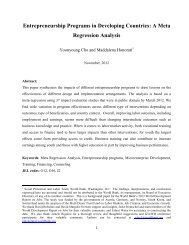Investing in the future: Creating opportunities for young rural ... - IFAD
Investing in the future: Creating opportunities for young rural ... - IFAD
Investing in the future: Creating opportunities for young rural ... - IFAD
Create successful ePaper yourself
Turn your PDF publications into a flip-book with our unique Google optimized e-Paper software.
of <strong>rural</strong> households and, as such, is most directly related to <strong>in</strong>terventions that<br />
improve physical and natural and f<strong>in</strong>ancial assets as well as job-related human<br />
capital through skills tra<strong>in</strong><strong>in</strong>g.<br />
The available evidence strongly suggests that comprehensive multiple services<br />
approaches (such as <strong>the</strong> Jovenes programmes <strong>in</strong> South America) are more<br />
effective than fragmented <strong>in</strong>terventions <strong>for</strong> generat<strong>in</strong>g susta<strong>in</strong>able employment<br />
<strong>opportunities</strong> <strong>for</strong> youth. However, such approaches are relatively expensive,<br />
which cont<strong>in</strong>ues to limit <strong>the</strong>ir applicability <strong>in</strong> most low-<strong>in</strong>come develop<strong>in</strong>g<br />
countries.<br />
Social capital and youth empowerment<br />
Youth, especially <strong>in</strong> <strong>rural</strong> areas, do not usually constitute an organized and vocal<br />
constituency with <strong>the</strong> economic and social power to lobby on <strong>the</strong>ir own behalf.<br />
Consequently, empower<strong>in</strong>g <strong>rural</strong> youth to take an active role <strong>in</strong> agriculture and<br />
<strong>rural</strong> development is critical. Successful youth policies also depend on effective<br />
representation by youth. Traditionally, despite <strong>the</strong>ir size, <strong>rural</strong> youth have had<br />
limited social and political power. Older people, and especially older males, tend<br />
to dom<strong>in</strong>ate decision mak<strong>in</strong>g at all levels <strong>in</strong> <strong>rural</strong> societies. In SSA, some writers<br />
refer to this as a gerontocracy. The subord<strong>in</strong>ate position of youth has been<br />
fur<strong>the</strong>r compounded by <strong>the</strong> traditional welfare approach – youth are viewed as<br />
present<strong>in</strong>g problems that need to be solved through <strong>the</strong> <strong>in</strong>tervention of older<br />
people. It is now widely accepted, however, that youth can play a major role <strong>in</strong><br />
improv<strong>in</strong>g governance nationally and locally, and <strong>in</strong> implement<strong>in</strong>g key economic<br />
and social policies. In particular, <strong>rural</strong> youth should be at <strong>the</strong> <strong>for</strong>efront of ef<strong>for</strong>ts<br />
to broaden <strong>opportunities</strong> <strong>for</strong> <strong>rural</strong> people. Urban bias with respect to macro-,<br />
sector- and meso-level policies and related resource allocations is also likely to<br />
become even more acute as <strong>the</strong> problems <strong>in</strong> urban areas <strong>in</strong>crease and needs to<br />
be countered. Well-designed <strong>in</strong>terventions are required to build up <strong>the</strong> political<br />
and social capital of <strong>rural</strong> youth. Youth have to be mobilized so that <strong>the</strong>y are able<br />
to participate fully and ga<strong>in</strong> ownership over youth development strategies and<br />
policies. This becomes even more challeng<strong>in</strong>g <strong>for</strong> <strong>young</strong> people who are under 18<br />
and who are, <strong>the</strong>re<strong>for</strong>e, still considered to be children.<br />
New ways of work<strong>in</strong>g with <strong>young</strong> people <strong>in</strong> <strong>rural</strong> areas are be<strong>in</strong>g pioneered <strong>in</strong><br />
many countries. Rural youth organizations and networks should be established<br />
and streng<strong>the</strong>ned. There are many excit<strong>in</strong>g developments <strong>in</strong> this area. For<br />
example, <strong>the</strong> <strong>IFAD</strong>-funded Rural Youth Talents Programme <strong>in</strong> South America is<br />
based on a new strategy that seeks systematize and publicize <strong>the</strong> experiences<br />
and lessons learned from <strong>rural</strong> youth programm<strong>in</strong>g. The ILO-supported Youth-to-<br />
Youth Fund <strong>in</strong> Cote d‟Ivoire, Gu<strong>in</strong>ea, Liberia, Sierra Leone and three East African<br />
countries (Uganda, Tanzania and Kenya) also demonstrates how youth-led<br />
organizations can effectively promote <strong>rural</strong>-based farm<strong>in</strong>g and non-farm<strong>in</strong>g<br />
enterprises. The Mercy Corps Youth Trans<strong>for</strong>mation Framework has adopted a<br />
similar approach <strong>in</strong> 40 fragile environment countries. Community Action Plans<br />
have been successfully piloted <strong>in</strong> Jordan, which map youth livelihood<br />
<strong>opportunities</strong> with <strong>the</strong> greatest potential and foster an entrepreneurial m<strong>in</strong>dset<br />
with a strong focus on life-skills tra<strong>in</strong><strong>in</strong>g. The provision of f<strong>in</strong>ancial services <strong>for</strong><br />
<strong>rural</strong> youth <strong>in</strong> Sierra Leone is ano<strong>the</strong>r pioneer<strong>in</strong>g <strong>in</strong>itiative (see box).<br />
9

















